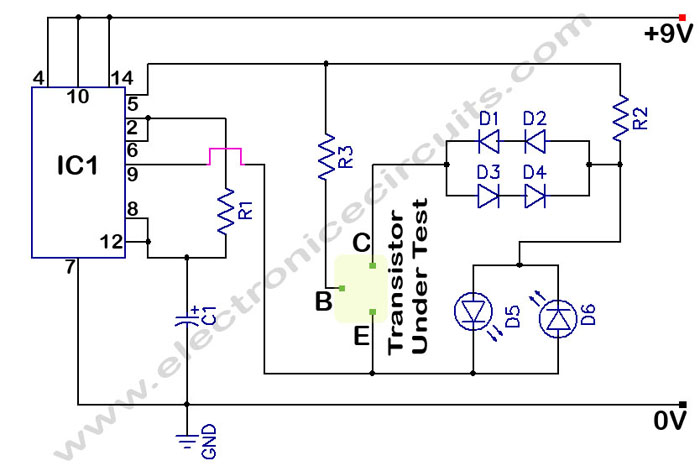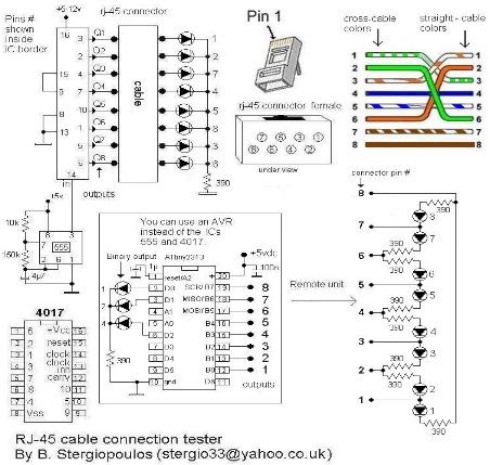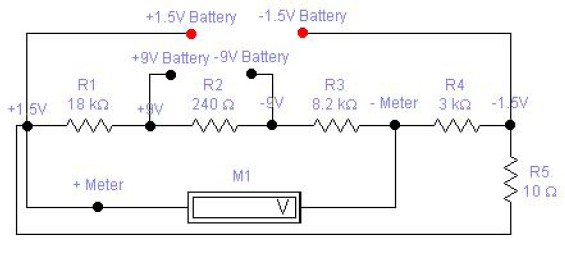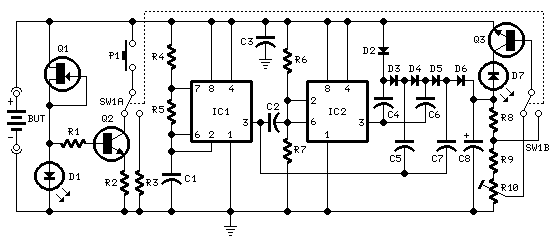
12/24/48 V D.C. Tester
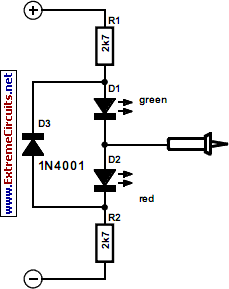
The current tester is designed primarily for testing 24 V electrical circuits commonly found in pleasure craft. However, by adjusting the resistor values, the circuit can be adapted for other voltage ranges. For a 12 V application, the resistors should be set to 1.2 kΩ, and for 48 V, they should be 4.7 kΩ. The tester is connected to the positive and negative voltage rails using test clips or crocodile clips, and the test probe is placed on the point to be tested. When the potential at the test point is positive, the red LED illuminates; if it is negative, the green LED lights up. Additionally, if the supply is not connected to earth, the tester can function as a ground-leak tester. In this case, one of the LEDs will illuminate when the test probe contacts a point at earth potential and detects a leakage.
The described tester serves as a versatile tool for diagnosing electrical circuits, particularly in marine applications. It incorporates a simple yet effective design that allows for easy adaptation to various voltage levels through resistor selection. The use of test clips or crocodile clips facilitates secure connections to the voltage rails, ensuring reliable measurements.
The circuit typically consists of a power supply section, LED indicators, and a resistor network. The power supply provides the necessary voltage for the operation of the LEDs and the measurement circuitry. The resistor values play a critical role in setting the voltage range for the tester. By selecting appropriate resistor values, the tester can be configured for 12 V, 24 V, or 48 V systems, thereby enhancing its utility across different applications.
The LED indicators are crucial for providing visual feedback during testing. The red LED signals a positive voltage, while the green LED indicates a negative voltage. This dual-indicator system allows users to quickly assess the voltage status at the test point. In addition to standard voltage testing, the ground-leak testing feature is particularly beneficial in identifying potential safety issues within the electrical system. By detecting leakage to earth potential, the tester aids in ensuring the integrity of the electrical installation.
Overall, this tester is an essential instrument for anyone working with electrical systems in pleasure craft, offering both functionality and adaptability to meet various testing needs.The present tester is intended primarily for testing the 24 V electrical circuits found on most pleasure craft. However, if the resistors are given different values, the circuit may, of course, be used for other voltage ranges.
For 12 V, the value of the resistors should be 1. 2 k, and for 48 V, 4. 7 k. The tester should be connected to the +ve an d ve voltage rails with test clips or crocodile clips, whereupon the test probe is placed on the point to be tested. When the potential at the point is positive, the red LED lights; if it is negative, the green one does.
If the supply is not connected to earth, the tester may be used as ground-leak tester. In this situation, one of the LEDs lights when the test probe touches a point at earth potential and there is a leakage. 🔗 External reference
The described tester serves as a versatile tool for diagnosing electrical circuits, particularly in marine applications. It incorporates a simple yet effective design that allows for easy adaptation to various voltage levels through resistor selection. The use of test clips or crocodile clips facilitates secure connections to the voltage rails, ensuring reliable measurements.
The circuit typically consists of a power supply section, LED indicators, and a resistor network. The power supply provides the necessary voltage for the operation of the LEDs and the measurement circuitry. The resistor values play a critical role in setting the voltage range for the tester. By selecting appropriate resistor values, the tester can be configured for 12 V, 24 V, or 48 V systems, thereby enhancing its utility across different applications.
The LED indicators are crucial for providing visual feedback during testing. The red LED signals a positive voltage, while the green LED indicates a negative voltage. This dual-indicator system allows users to quickly assess the voltage status at the test point. In addition to standard voltage testing, the ground-leak testing feature is particularly beneficial in identifying potential safety issues within the electrical system. By detecting leakage to earth potential, the tester aids in ensuring the integrity of the electrical installation.
Overall, this tester is an essential instrument for anyone working with electrical systems in pleasure craft, offering both functionality and adaptability to meet various testing needs.The present tester is intended primarily for testing the 24 V electrical circuits found on most pleasure craft. However, if the resistors are given different values, the circuit may, of course, be used for other voltage ranges.
For 12 V, the value of the resistors should be 1. 2 k, and for 48 V, 4. 7 k. The tester should be connected to the +ve an d ve voltage rails with test clips or crocodile clips, whereupon the test probe is placed on the point to be tested. When the potential at the point is positive, the red LED lights; if it is negative, the green one does.
If the supply is not connected to earth, the tester may be used as ground-leak tester. In this situation, one of the LEDs lights when the test probe touches a point at earth potential and there is a leakage. 🔗 External reference
